Closet Door Makeover: How to Make any Door Beautiful
This inexpensive closet door makeover completely transformed a pair of bland closet doors with chevron wood planks and a fresh coat of paint.
A few days ago I shared the first step in our epic sliding closet door makeover – converting the sliding doors to hinged doors.
That change made a huge difference in making our closet doors more functional and today I want to share how I also made them beautiful!
The plain flat-panel closet doors we had were fine, but they were exceptionally boring and bland. So I gave them a major update with chevron wood planks and a pretty paint color.
I’ve been a huge fan of using wood planks to add texture to walls for awhile now. The colorful wood plank wall I added to our foyer and the herringbone wood wall in our master bath are a few of my favorite projects. So I was instantly onboard for trying a DIY wood planked door.
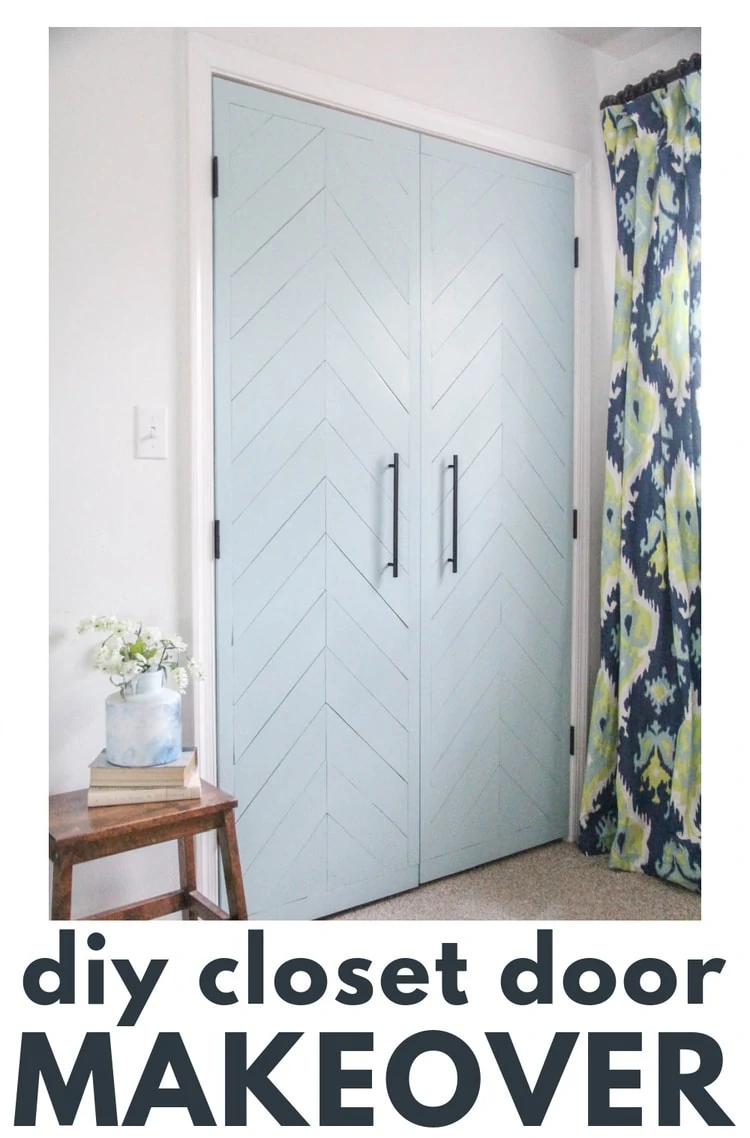
This project is a bit time-intensive, but it is very inexpensive and makes a huge impact!
This same method will work well for transforming any flat panel door whether its a closet door, barn door, or any other interior door.
This post contains affiliate links which means if you make a purchase after clicking a link I will earn a small commission but it won’t cost you a penny more. Click here to see my full disclosure policy.
Materials
- flat panel door ready for a makeover
- wood to frame the door face – 1/4″ thick x 2 ” wide, long enough to outline each door
- wood for the chevron pattern – 1/4″ thick x 4″ wide strips
- pencil
- wood glue
- spackling
- 220 grit sandpaper
- paint in the color of your choice – I used Sherwin Williams ‘Watery’
- paint brush – this is my favorite paint brush for DIY
- foam paint roller
- door handles – I used this set from Amazon which I highly recommend. They look beautiful and were very affordable.
Tools
- nail gun – this is the one I have and love. It is easy to use and doesn’t require an air compressor.
- circular saw or table saw – for cutting your wood into strips.
- miter saw – for cutting the strips at an angle.
- speed square – this is a must-have for creating a clean chevron pattern
- tape measure
- straight edge
- utility knife or paint scraper – for getting clean paint lines between the wood planks
- drill – for attaching the handles
How to Update Doors with Chevron Wood Planks
Choose your Wood
You want to use very thin wood planks for a project like this; 1/4″ plywood is perfect.
This will help keep the door from getting too heavy and also keeping the wood thin ensures it won’t get in the way of the hinges when the door is fully open.
The most cost-effective option is to buy a big piece of underlayment or other inexpensive plywood and cut it into strips yourself.
Underlayment is a thin plywood that is very cheap because it isn’t the highest quality. You won’t want to use underlayment for projects you are planning to stain, but when you are using paint, it works just fine. I used underlayment for the herringbone wood wall in my bathroom and it worked perfectly.
If you want to save a bit of time, you can buy 2″ wide lattice boards for the frame around the edges of the door and just use your plywood to create the chevron pattern. Or if you’d rather keep costs down, you can simply cut everything from the plywood.
I had some scrap lattice from a previous project that I used for my own doors.
Create the outer frame
It’s pretty difficult to get the angled edges of a chevron or herringbone pattern to make a perfectly straight line, so adding a simple frame around the door first really helps everything line up more neatly.
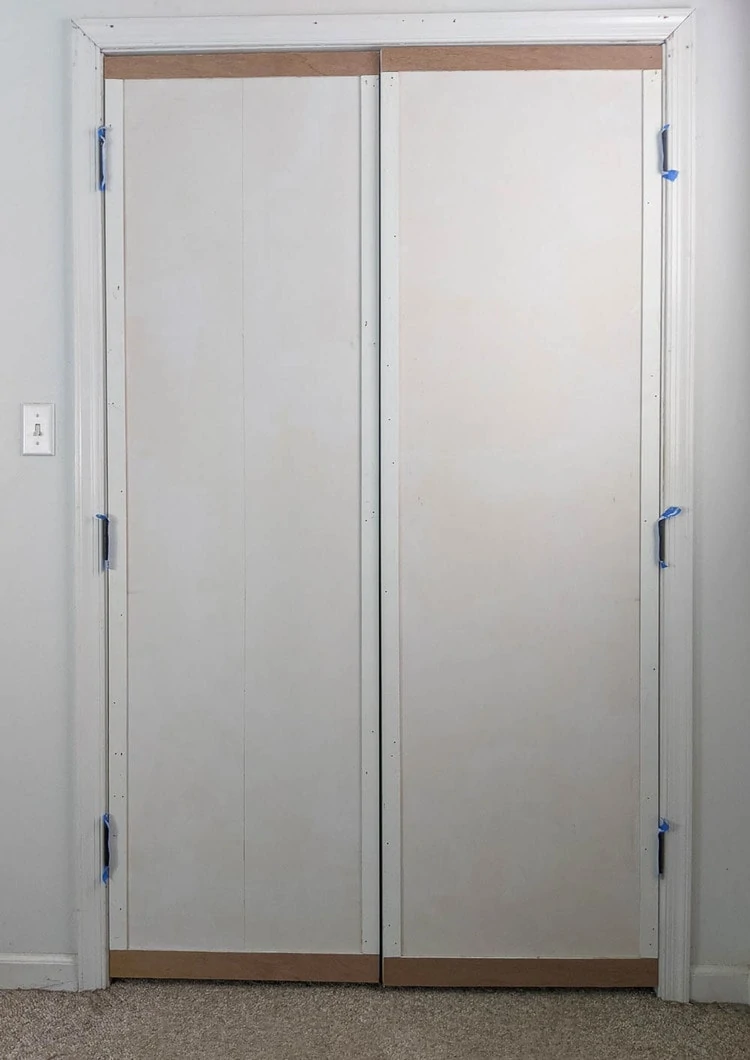
Cut each board to the correct length and then attach it using wood glue and nails.
For wood plank walls, I typically skip the wood glue and just use nails to hold the planks in place. This way it’s a lot easier to remove them in the future if needed. But since this time I’m working on doors that will be regularly opened and closet, I decided to use both glue and nails to help keep everything firmly attached.
A nail gun makes a project like this go so much faster. I have this Ryobi nail gun and I’m a big fan. It’s very easy to use and doesn’t require an air compressor. If you don’t have a nail gun, you can use a hammer and nails instead, but it will take a lot more time.
Cut your wood planks
When working with big sheets of plywood, I usually have them cut it into smaller strips in the store to make it easier to transport home. They may be willing to cut it into 4″ wide strips for you right in the store, but I usually just have them cut the board into half or fourths and cut it the rest of the way at home.
You can cut your own wood into strips using a circular saw or a table saw. I found 4″ strips to be a good size but you could always make yours larger or smaller depending on the look you prefer.
Once your wood is cut into strips, use a miter saw to cut a 45 degree angle at one end of each strip.
I find it works best to cut half of the strips and then adjust the saw to cut a 45 degree angle in the other direction for the second half of the strips.
Because underlayment isn’t the highest quality wood, one side is usually nicer than the other. Cutting the angles from different directions this way makes it easier to keep the good side facing up as you lay out your pattern.
Be sure to sand each cut edge to remove any rough edges.
Begin the chevron pattern
Use a tape measure and a straight edge to draw a line down the center of each door.
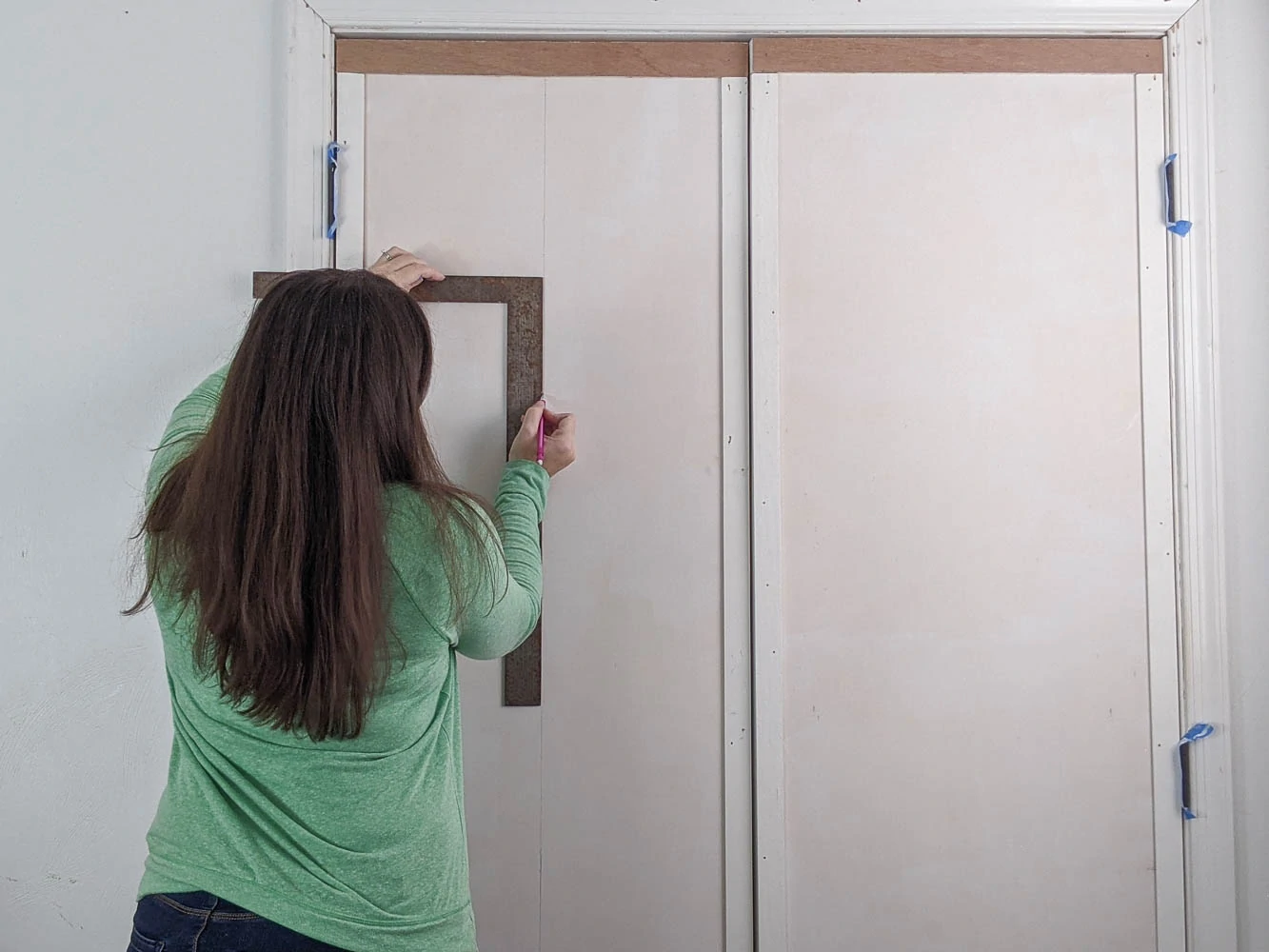
To start the chevron pattern, line up the angled edges of two wood planks so they meet on this straight line.
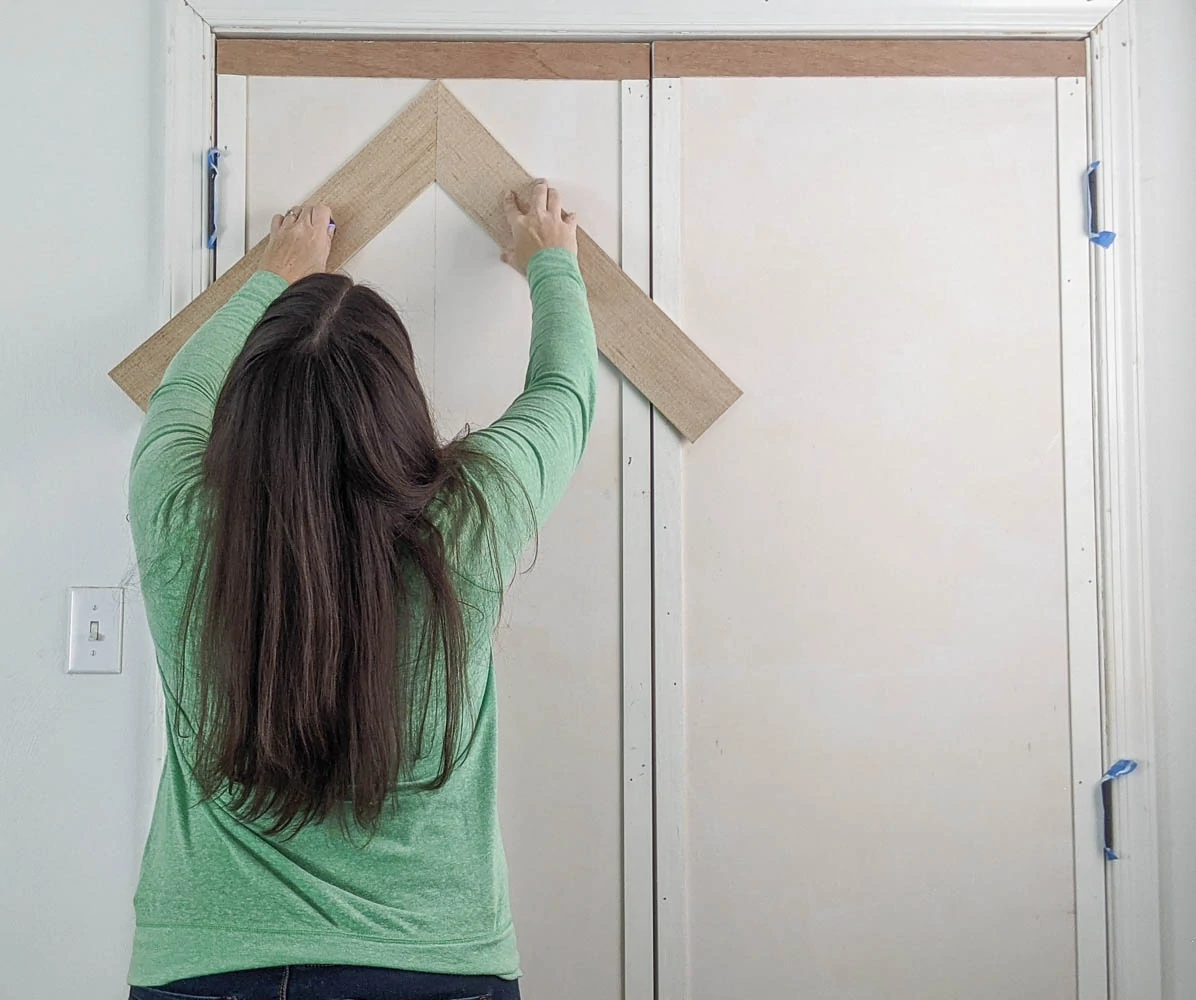
Use a speed square to make sure that each board is exactly 45 degrees from the top of the door.
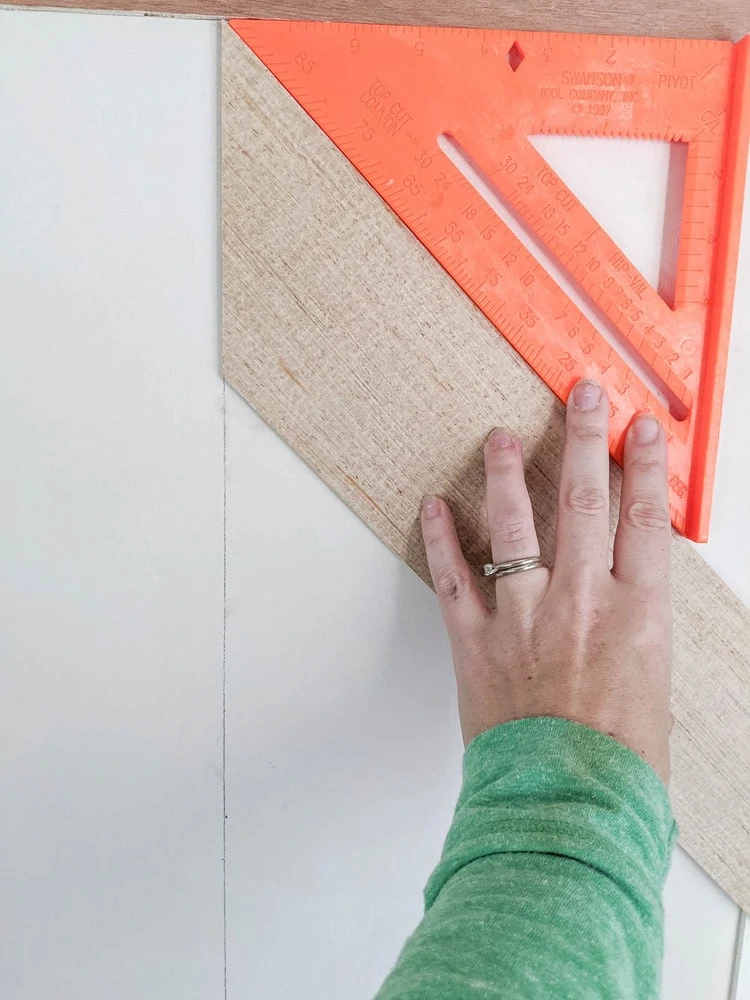
It’s really important to make sure these first two boards are lined up correctly because they are setting the pattern for the whole rest of the door. If they are off-center or attached at the wrong angle, you will have to fight with every other board going down the door to get it correctly placed.
While holding each board in place, use the speed square or another straight edge to mark where the second end meets the door frame.
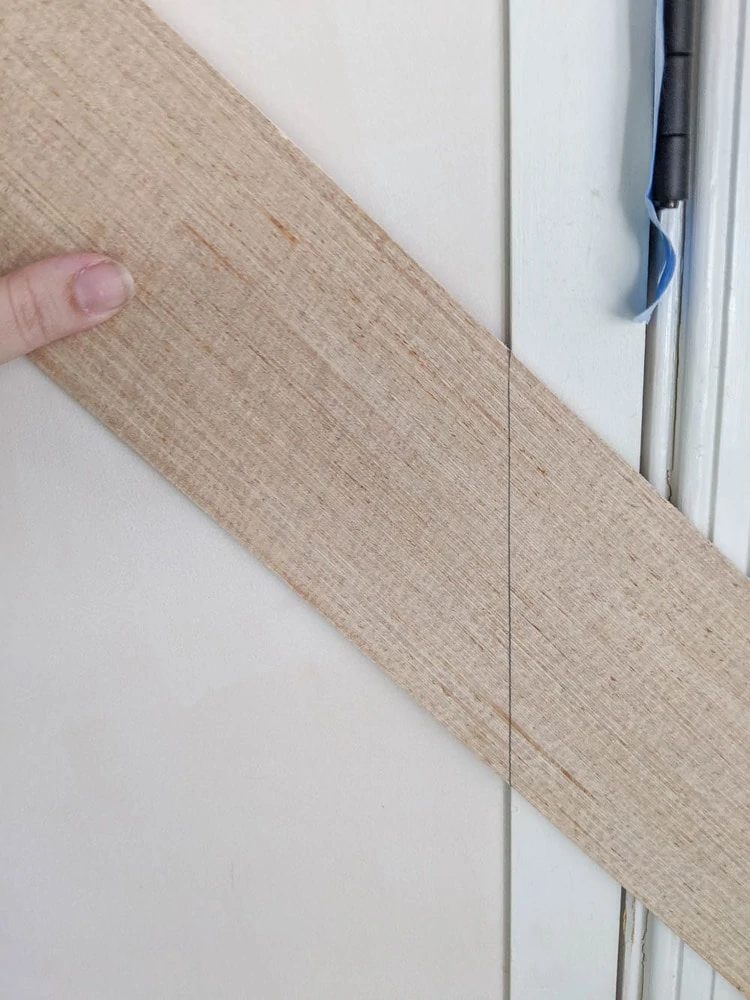
Cut along this mark with your miter saw. Once the first row is cut, double-check the fit and then attach each board using wood glue and nails.
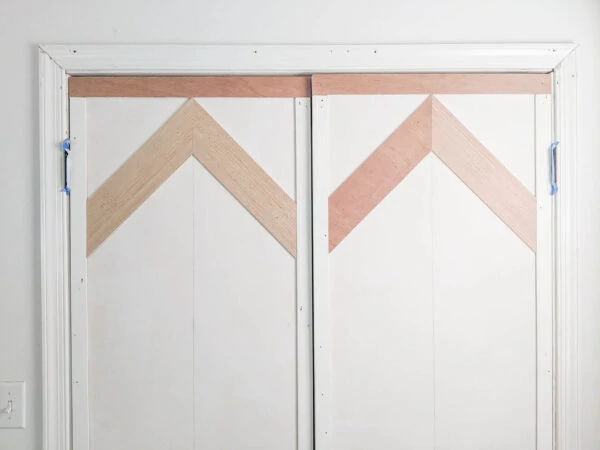
Continue the pattern
Continue down the door, cutting and attaching the wood planks as you go.
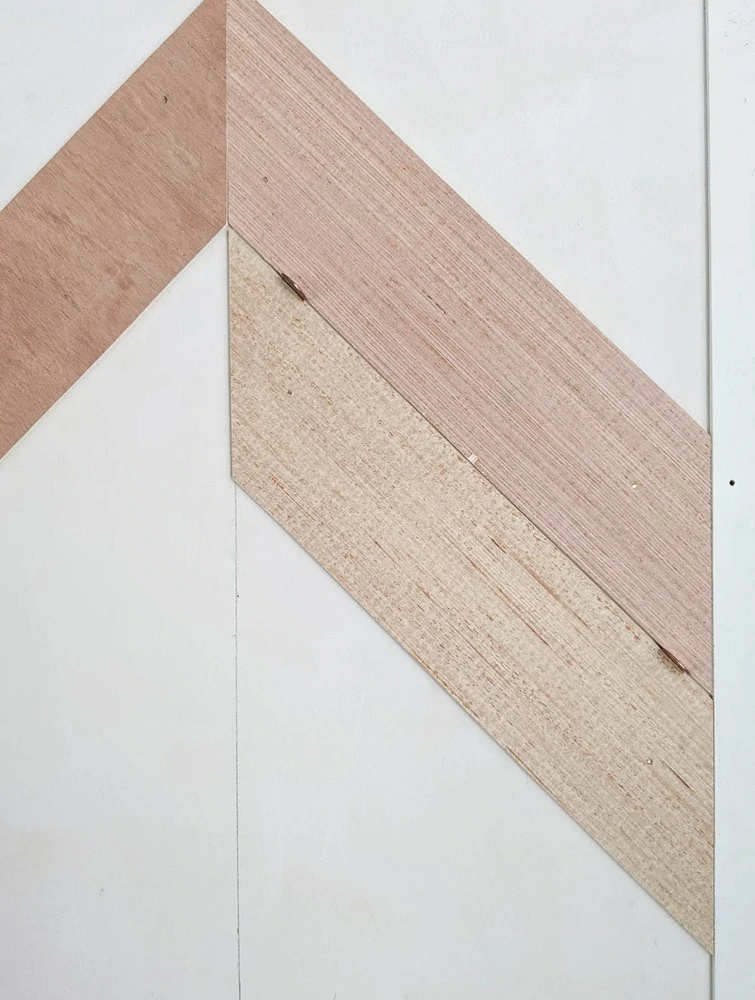
As you can see in the photo above, I started out using pennies as spacers to create a small gap between each board. You don’t want the boards to be completely flush with one another or the chevron pattern will be somewhat lost once the doors are painted.
After the first couple of rows, I realized the pennies really weren’t necessary and were just getting in the way. For the rest of the wood planks, I simply made sure to leave a tiny gap between each board as I attached them.
It would save a lot of time to simply cut all of the wood strips the same size from the beginning, but I found I got a much better fit by measuring and cutting each strip to the correct angle individually.
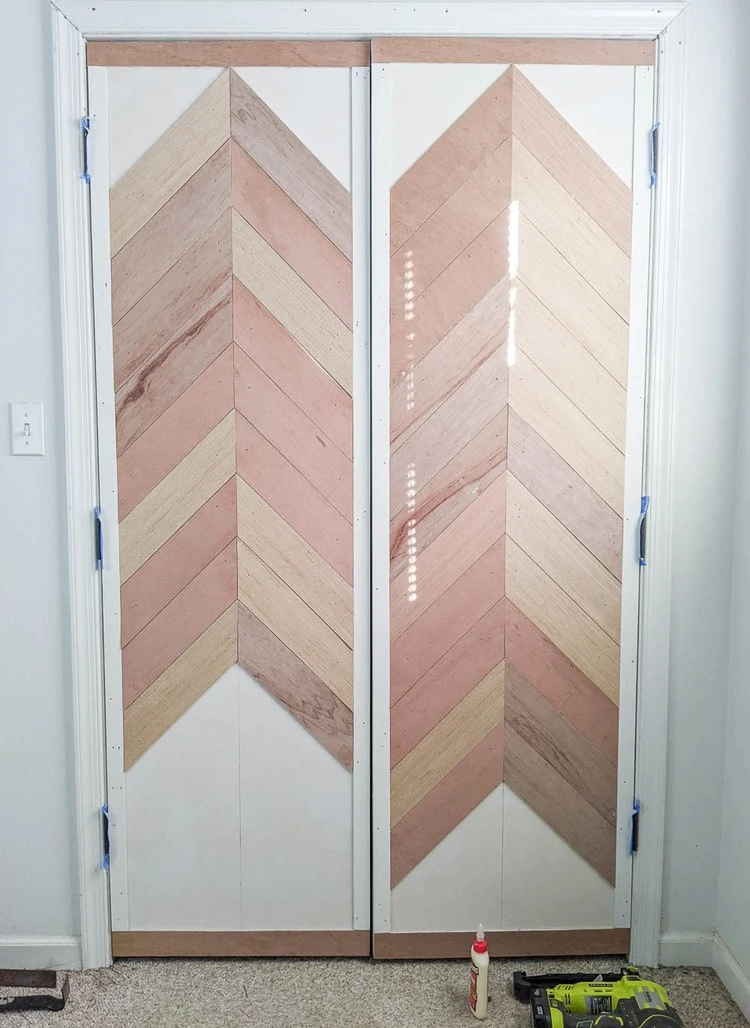
When you reach the bottom of the door, there will be a few odd shaped pieces to cut to complete the pattern all the way to the corners. Just continue to mark where each piece needs to be cut and cut it with your miter saw.
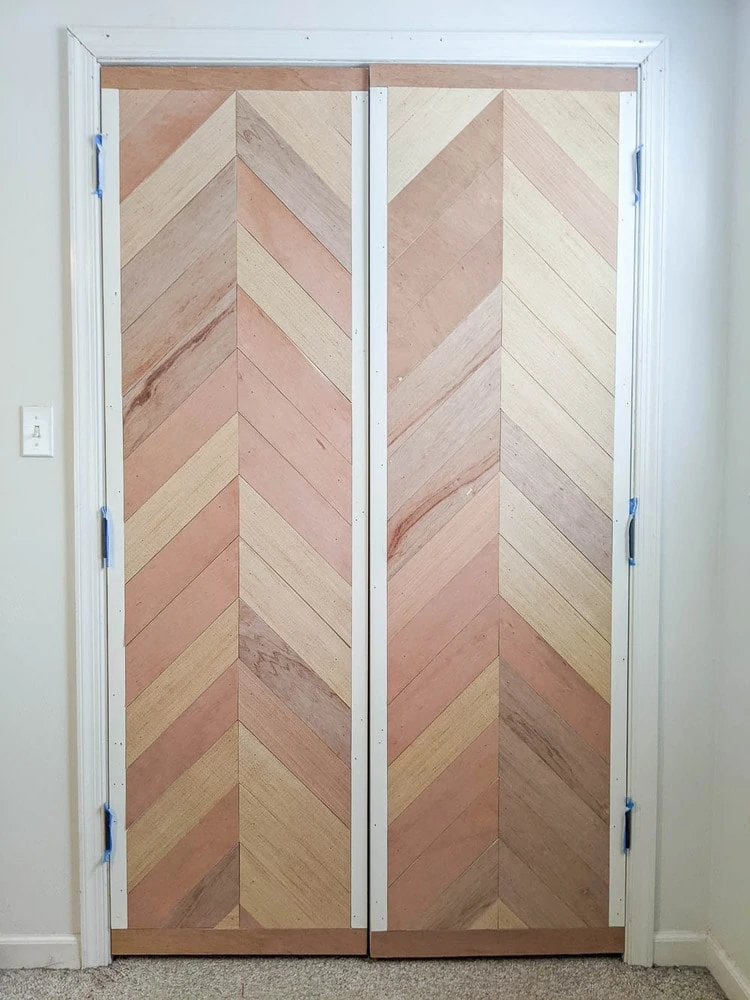
Fill the nail holes
Before painting, I filled all of the tiny nail holes in my door with spackling. At the same time I also filled a few small areas where the wood looked a bit ragged along the cut edges.
Once the spackling dried, I sanded it smooth with 220 grit sandpaper.
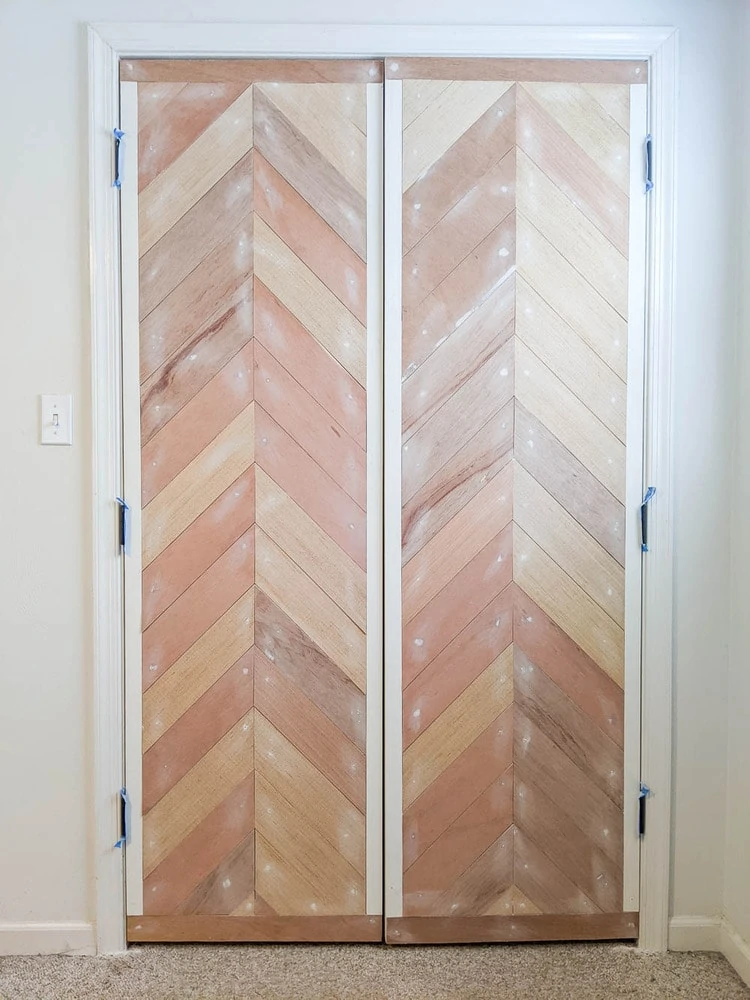
Paint the doors
Now you are ready to paint!
I protected the hinges with painter’s tape. Then I used my favorite angled paint brush to paint around the edges of the doors and filled in with a small foam paint roller.
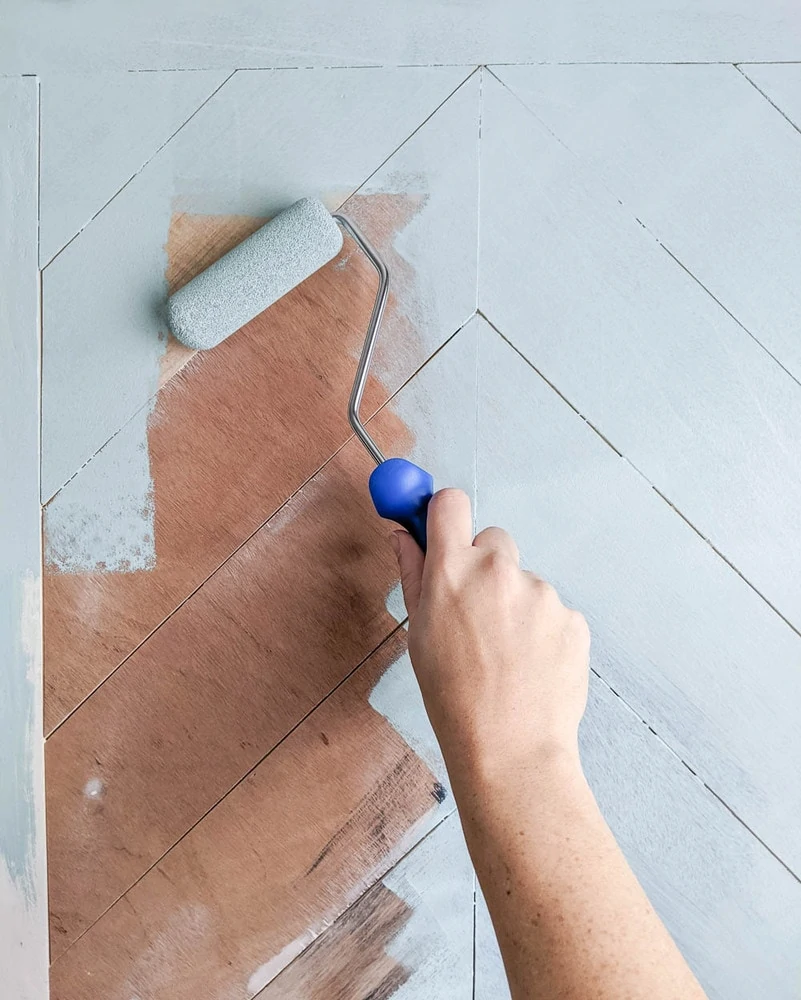
I painted my doors the color Watery by Sherwin Williams because I really wanted them to make a statement. It’s a beautiful blue with hints of green and gray as well. If you would prefer for your doors to be a bit more subtle, they would also look beautiful painted white.
Once the paint dried, you can use a utility knife or paint scraper to gently remove any paint that may have accumulated between the wood planks. This is one of those small details that will make your finished doors look professionally built.
Add the handles
The final step is to predrill holes and add the handle or handles.
I used these handles from Amazon and I’m really happy with them. They look great and are super affordable.
Chevron Wood Plank Doors
And here they are – my beautiful ‘new’ closet doors!
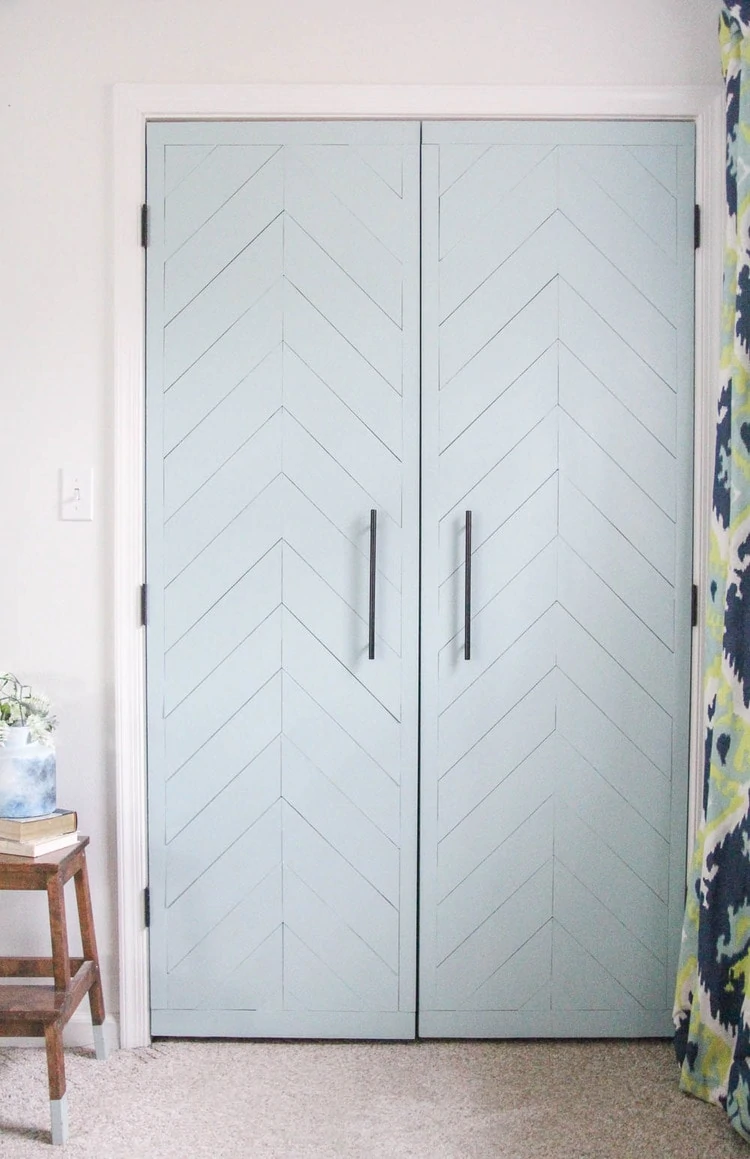
I absolutely love them!
I love that they open fully now, unlike when they were sliding doors and I could only see one side of the closet at a time. I love how fresh and beautiful they look. And I love that I was able to upcycle my old doors to make these!
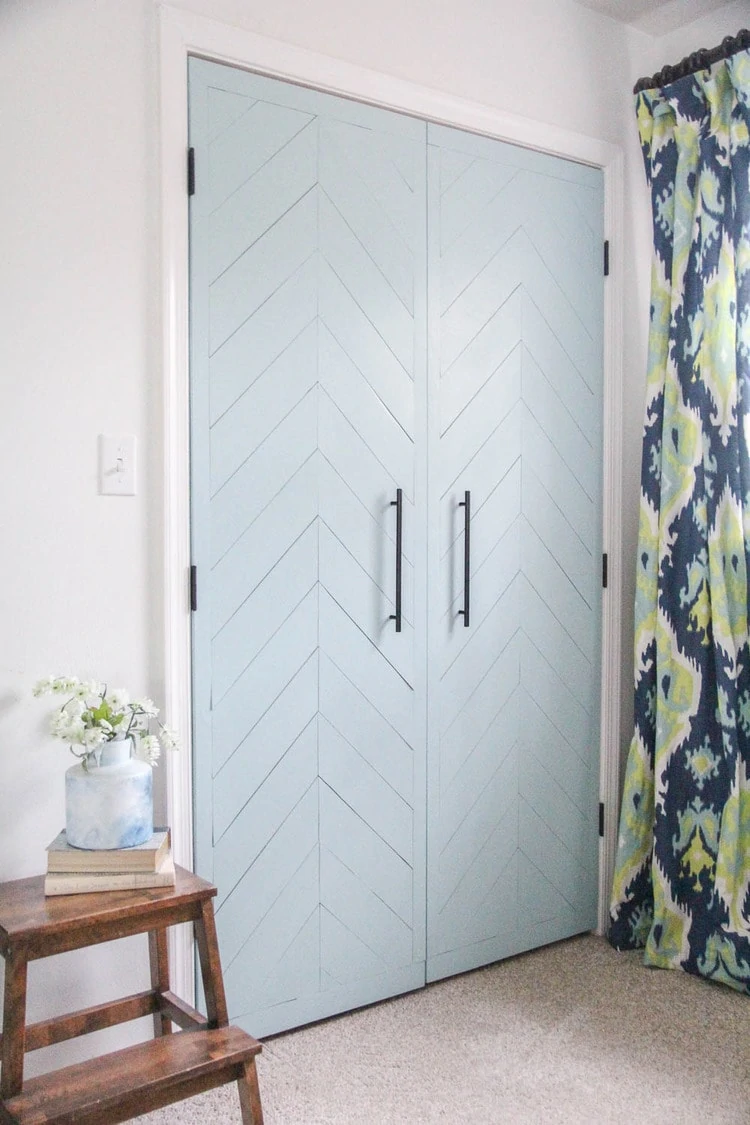
Time and Cost
This wasn’t a super quick project; but it can easily be done in a weekend. It took about 6 hours to cut and attach all of the wood for this door, paint the door, and add the handles.
For such a huge transformation, it was very affordable. The cost for the plywood and paint came to $40.
Combining this with the cost for the first half of this project, converting the sliding doors to hinged doors, brings the total cost for this sliding closet door makeover to $70. Not bad considering the high price of even the most basic replacement doors.
Next step: tackling the mess inside that closet with a DIY closet organizer!
Video Tutorial
If you prefer to see things done, this video shows the entire closet door makeover start to finish.
I’d love for you to subscribe to my Youtube channel!
Other DIY ideas I think you’ll like:
- How to Completely Transform your Sliding Closet Doors
- How to DIY a Herringbone Wood Wall on a Budget
- How to Make a Stunning DIY Wood Plank Wall
- Our Modern Sliding Barn Door
I’d love for you to pin this post on Pinterest!
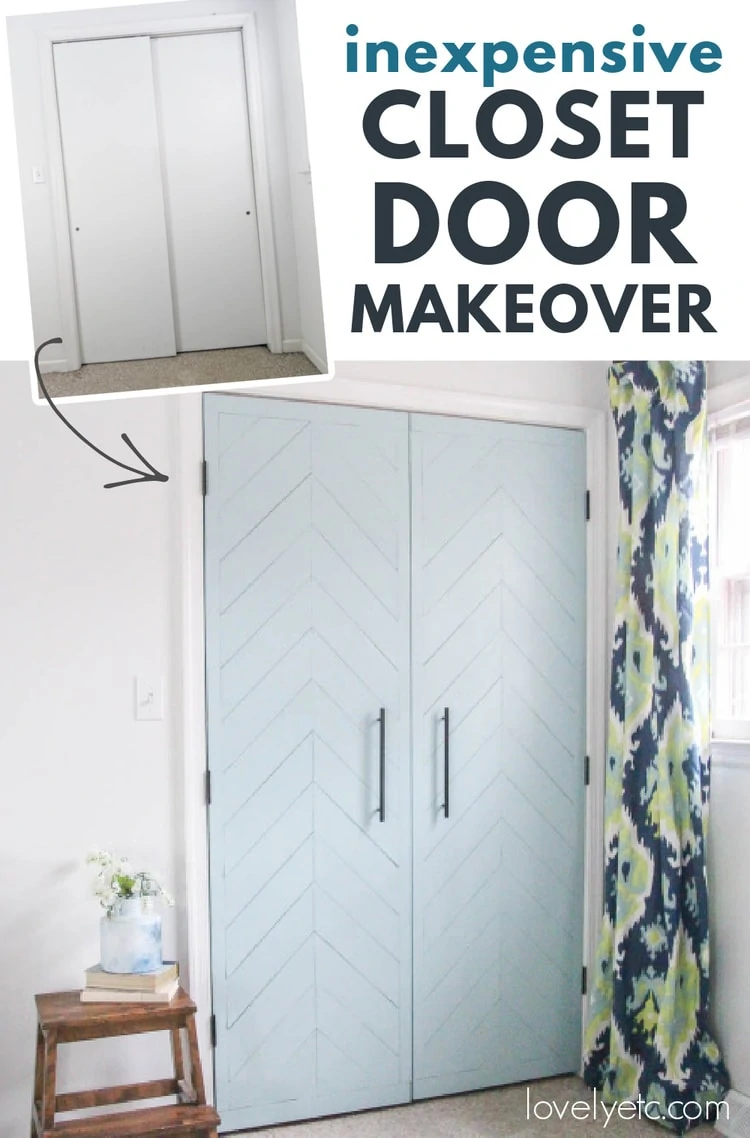

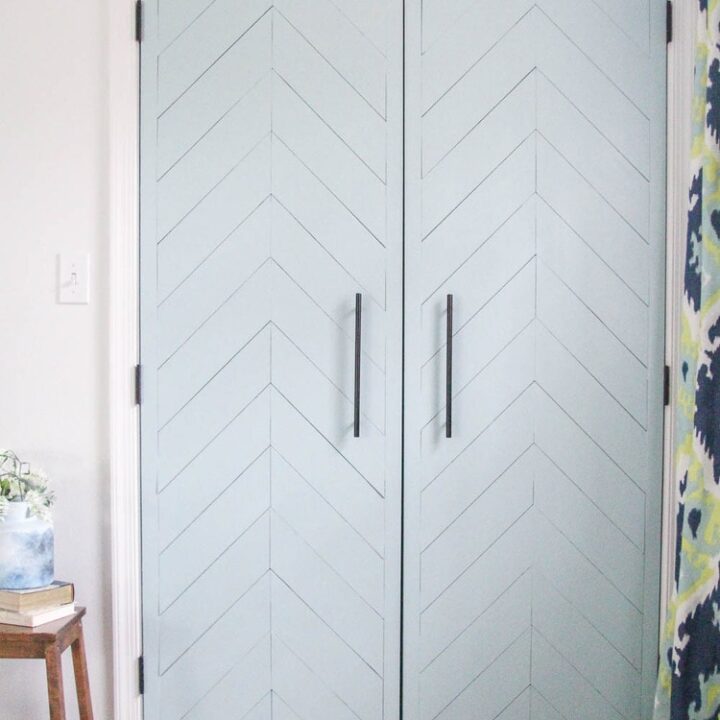
Closet Door Makeover: Chevron Wood Plank Closet Doors
Add texture and interest to plain closet doors with a DIY wood planked door. This closet door makeover is not only beautiful, but it's easier than you think to make!
Materials
- flat panel door
- 1/4" thick x 2" wide strips of wood to frame the door face
- 1/4" thick x 4" wide strips of wood for the chevron pattern
- pencil
- wood glue
- spackling
- 220 grit sandpaper
- paint in the color of your choice
- door handles
- foam paint roller
- paint brush
Tools
- nail gun
- circular saw or table saw
- miter saw
- speed square
- tape measure
- straight edge
- utility knife or paint scraper
- drill
Instructions
- Cut the wood to the correct length to form the outer frame.
- Attach it using wood glue and nails.
- Cut your wood planks into 4" strips with a circular or table saw.
- Use a miter saw to cut a 45 degree angle at one end of each strip.
- Sand each cut edge to remove any rough edges.
- Use a tape measure and a straight edge to draw a line down the center of each door.
- Line up the angled edges of two wood planks to meet on this straight line.
- Use a speed square to make sure that each board is exactly 45 degrees from the top of the door.
- Hold each board in place, use the speed square or another straight edge to mark where the second end meets the door frame.
- Cut along this mark with your miter saw.
- Attach each board using wood glue and nails.
- Continue cutting and attaching the wood planks this way as you move down the door.
- Fill in the nail holes with spackling.
- Sand with 220 grit sandpaper to smooth the spackling and any rough edges.
- Tape off the hinges and paint the doors the color of your choice with a foam paint roller.
- Use a utility knife or paint scraper to remove any paint that puddles between the wood planks for a smoother look.
- Add your handles.
Recommended Products
As an Amazon Associate and member of other affiliate programs, I earn from qualifying purchases.
-
CRAFTSMAN Tape Measure, 25-Foot (CMHT37325S)
-
SKIL 5280-01 15-Amp 7-1/4-Inch Circular Saw with Single Beam Laser Guide
-
Ryobi 3 Piece 18V One+ Airstrike Brad Nailer Kit (Includes: 1 x P320 Brad Nailer, 1 x P190 18-Volt ONE+ 2.0 Ah lithium-ion battery, P118 dual chemistry charger (Renewed)
-
Fandeli 36027 220 Grit Multipurpose Sandpaper Sheets, 9" x 11", 25-Sheet
-
Titebond 5064 Original Wood Glue, 16-Ounces
-
Probrico (5 Pack) 10" Center to Center Black Modern Cabinet Pulls Stainless Steel Cabinet Hardware Bedroom Drawer Pull Kitchen Cabinet T Bar Handle Dresser Pulls







This turned out LOVELY!! Congrats on a creative solution that will help many in the same situation.
Thank you so much!
Goodness that is beautiful!
Thank you!